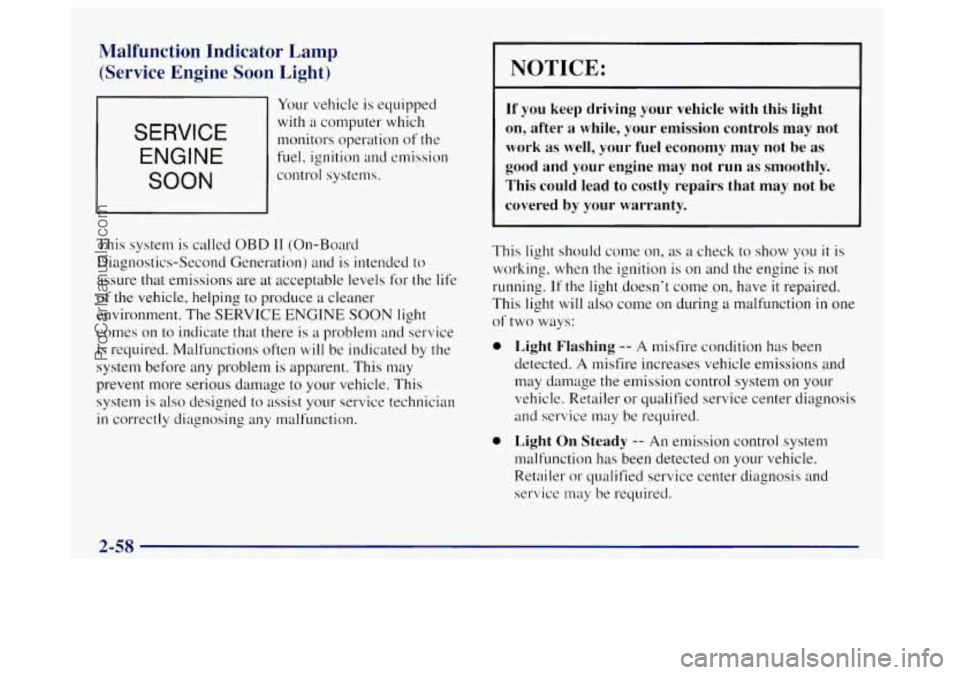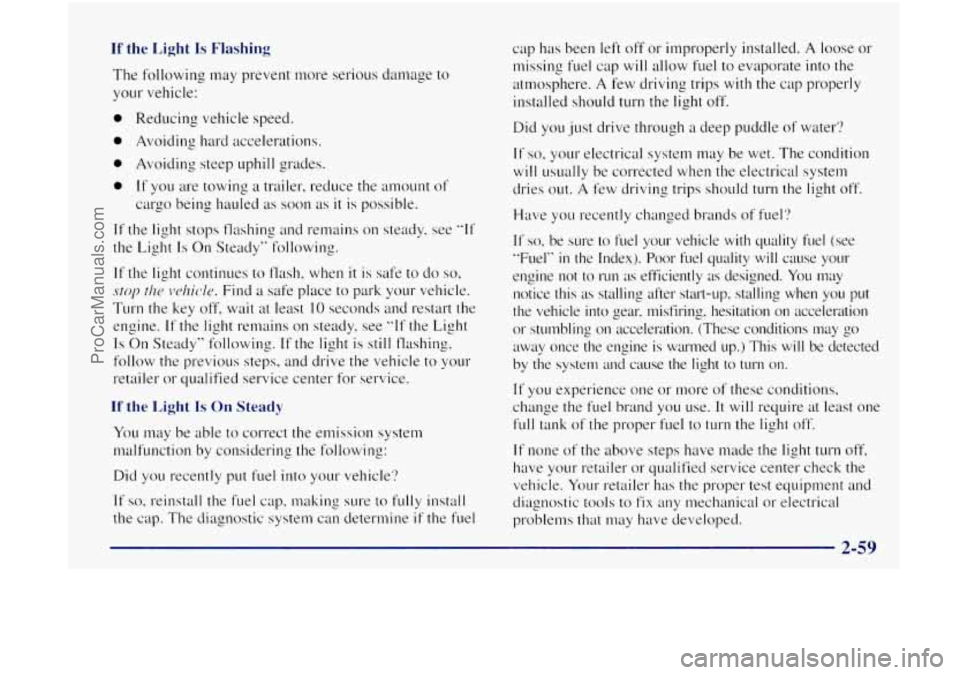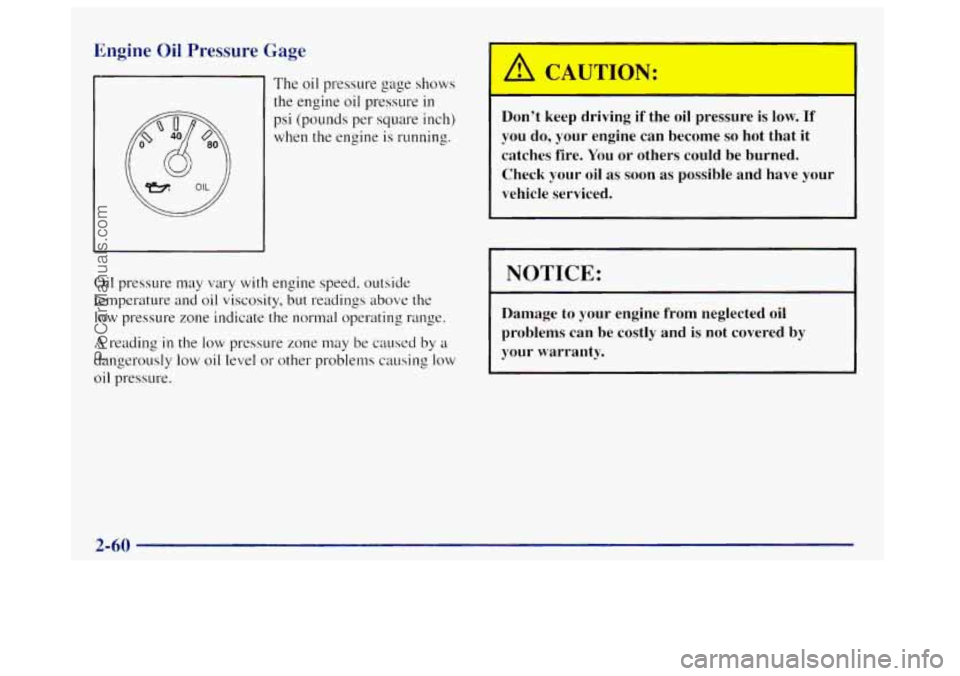engine OLDSMOBILE BRAVADA 1998 Owner's Manual
[x] Cancel search | Manufacturer: OLDSMOBILE, Model Year: 1998, Model line: BRAVADA, Model: OLDSMOBILE BRAVADA 1998Pages: 380, PDF Size: 19.2 MB
Page 121 of 380

Anti-Lock Brake System Warning Light
~ With the anti-lock brake
system, this light will
come on when you start
your e.ngine and may stay
on
for several seconds.
That’s normal.
If the light stays on, or comes on when you’re driving,
your vehicle needs service.
If the regular brake system
warning light
isn’t on, you still have brakes, but you
don’t have anti-lock brakes.
If the regular brake system
warning light
is also on, you don’t have anti-lock brakes
and there’s
a problem with your regular brakes. See
“Brake System Warning Light“ earlier
in this section.
The anti-lock brake system warning light should come
on briefly when you
turn the ignition key to RUN. If the
light doesn’t come on
then, have it fixed so it will be
ready to warn you
if there is a problem.
Engine Coolant Temperature Gage
This gage shows the
engine coolant temperature.
If the gage pointer moves
into the red area. your
engine is too hot!
It means that your engine coolant has overheated. If you
have been operating your vehicle under normal driving
conditions, you should pull
off the road. stop your
vehicle and
turn off the engine as soon as possible.
In “Problems on the Road,“ this manuill shows you what
to do. See “Engine Overheating”
in the Index.
2-57
ProCarManuals.com
Page 122 of 380

Malfunction Indicator Lamp
(Service Engine Soon Light)
SERVICE
ENGINE
SOON
Your vehicle is equipped
with a computer which
monitors operation of the
fuel, ignition and emission
control systems.
NOTICE:
If you keep driving your vehicle with this light
on, after a while, your emission controls may not
work as well, your fuel economy may not be as
good and your engine may not run as smoothly.
This could lead
to costly repairs that may not be
covered by your warranty.
This system is called OBD I1 (On-Board
Diagnostics-Second Generation) and is intended to
assure that emissions are at acceptable levels for the life
of the vehicle, helping to produce a cleaner
environment. The
SERVICE ENGINE SOON light
comes
on to indicate that there is a problem and service
is required. Malfunctions often
will be indicated by the
system before
any problem is apparent. This may
prevent more serious damage to your vehicle. This
system
is also designed to assist your service technician
in correctly diagnosing any malfunction. This
light should
come on, as a check to show you it is
working. when the ignition is
on and the engine is not
running. If the light doesn’t come on, have it repaired.
This light will
also come on during a malfunction in one
of two ways:
0
0
Light Flashing -- A misfire condition has been
detected.
A misfire increases vehicle emissions and
may damage the emission control system
on your
vehicle. Retailer or qualified service center diagnosis
and service may be required.
Light On Steady -- An emission control system
malfunction has been detected on your vehicle.
Retailer or qualified service center diagnosis and
service may be required.
2-58
ProCarManuals.com
Page 123 of 380

If the Light Is Flashing
The following may prevent more serious damage to
your vehicle:
0 Reducing vehicle speed.
0 Avoiding hard accelerations.
0 Avoiding steep uphill grades.
0 If you are towing a trailer, reduce the amount of
cargo being hauled
as soon as it is possible.
If the light
stops flashing and remains on steady, see "If
the Light
Is On Steady'. following.
If the light continues to flash, when it is safe to clo so,
stop the vel?icle. Find a safe place to park your vehicle.
Turn the key off, wait at least 10 seconds and restart the
engine.
If the light remains on steady, see "If the Light
Is On Steady" following. If the light is still .flashing,
follow the previous steps, and drive the vehicle to your
retailer or qualified service center for service.
If the Light Is On Steady
YOLI may be able to correct the emission system
malfunction by considering
the following:
Did you recently
put fuel into your vehicle'?
If so, reinstall the fuel cap, making sure to fully install
the cap. The diagnostic system can determine
if the fuel cap
has been left off or improperly installed.
A loose or
missing fuel cap
will allow fuel to evaporate into the
atmosphere.
A few driving trips with the cap properly
installed should turn the light off.
Did you just drive through a deep puddle
of water?
If so, your electrical system may be wet. The condition
will usually be corrected when the electrical system
dries out. A few driving trips should
turn the light off.
Have you recently changed brands
of fuel?
If so, be s~~re to file1 your vehicle with quality fuel (see
"Fuel"
in the Index). Poor fuel quality will cause your
engine not
to run as efficiently as designed. You may
notice
this as stalling after start-up, stalling when you put
the vehicle into gear, misfiring, hesitation on acceleration
or stumbling on acceleration. (These conditions may go
away once the engine is warmed up.) This
will be detected
by the system and cause the light to turn
on.
If YOLI experience one or more of these conditions,
change the fuel brand
yo^^ use. It will require at least one
full tank of the proper fuel to turn the light off.
If none of the above steps have made the light turn off,
have your retailer or qualified service center check the
vehicle. Your retailer has the proper test equipment and
diagnostic tools
to fix any mechanical or electrical
problems that may have developed.
ProCarManuals.com
Page 124 of 380

Engine Oil Pressure Gage
The oil pressure gage shows
the engine
oil pressure in
psi (pounds per square inch)
when the engine
is running.
Oil pressure may vary with engine speed, outside
temperature and oil viscosity, but readings above the
low pressure zone indicate the normal operating range.
A reading in the low pressure zone may be caused by a
dangerously low oil level or other problems causing low
oil pressure.
I
Don’t keep driving if the oil pressure is low. If
you do, your engine can become so hot that it
catches fire.
You or others could be burned.
Check
your oil as soon as possible and have your
vehicle serviced.
1 NOTICE:
Damage to your engine from neglected oil
problems can
be costly and is not covered by
your warranty.
ProCarManuals.com
Page 125 of 380

Security Warning Light
This light will come on
briefly when you turn the
key toward
START. The
light will stay on
until the
engine starts.
Service 4WD Light
This light should come on
briefly when you turn on the
SERVICE
4WD
I ignition, as a check to show
If the light flashes, the Passlock system has entered a
tamper mode. If the vehicle fails to start, see "Passlock"
in the Index.
If the light comes on continuously while driving and
stays on, there may be a problem with the Passlock
system. Your vehicle
will not be protected by Passlock,
and you should see your retailer. The
SERVICE 4WD light
comes on to indicate that
there may be
a problem with the drive system and
service is required. Malfunctions can be indicated by the
system before any problem is apparent, which may
prevent serious damage to
the vehicle. This system is
also designed
to assist your service technician in
correctly diagnosing a malfunction.
ProCarManuals.com
Page 126 of 380

Check Gages Light
CHECK
GAGES
The CHECK GAGES light
will come on briefly when
you are starting the engine.
Gate Ajar
GATE
AJAR
This light will come on
briefly when you are
starting your engine.
If the light comes on and stays on while YOLI are driving, If it stays on, you’re liftgate is ajar. Try closing the
check your coolant temperature and engine
oil pressure liftgate again. Never drive with the liftgate even
gages
to see if they are in the warning zones.
partially open.
2-62
ProCarManuals.com
Page 131 of 380

~ . le Knob - Automatic
Operation
I he right knob on the control panel allows you to
choose the direction of air delivery. When the system is
set
for automatic operation, sensors will control the air
delivery mode. Air will come primarily from the floor
or
instrument panel outlets, with some air directed to the
windshield to prevent fogging.
When the system is
in AUTO mode, the air conditioning
light will turn on, and
the recirculation and outside air
lights
turn off. With the system in full auto control
(both the fan and mode knobs
in AUTO), YOLI still
have the ability to override any function. However?
continually overriding the outside air or the A/C
compressor will
limit the ability of the system to cool
the vehicle quickly.
If you push a button for a function which is not
available, the light next to that button
will flash three
times to alert you that it's
not available.
To find your comfort zone, start with the
74°F (23°C)
setting and allow about 20 minutes for the system to
adjust the temperature
if necessary.
With the automatic setting, the air conditioning
compressor automatically cycles when needed to cool
the air.
In cold weather, when the system senses the need
for heat, the airflow will be directed out the floor outlets.
As the
interior temperature approaches a desired
setting,
the blower speed will decrease. To maintain
interior comfort, the airflow will adjust between the
instrument panel air outlets and
floor outlets. On bright
sunny days in cool weather, the airflow may come out
of
the air conditioning and floor outlets (bi-level mode) to
maintain comfort and prevent stuffiness.
To avoid blowing cold air
in cold weather, the system
will delay turning on the fan until warm air is available.
The length of delay depends on the outside air
temperature, engine coolant temperature or the time
since the engine was last started.
As the coolant
warms
up, the blower fan speed will gradually increase
and air will flow from the heater outlets, with some
airflow to the windshield to prevent fogging under most
normal conditions.
If your vehicle is sitting out on a warm day and you
have the filn set on AUTO, the air
will first flow out of
the floor air outlets for
a few seconds. That is normal.
This is to expel hot air from the air outlets.
As the air is
cooled, the airflow
will move through the air
conditioning outlets.
Be careful
not to put anything over the solar sensor
located around the center of the instrument panel.
This sensor is used by the automatic system
to
regulate temperature.
3-3
ProCarManuals.com
Page 133 of 380

Remember that in order for the automatic system
to perform
well, it needs A/C to provide
cooling performance.
Air Conditioning
On hot days, open the windows long enough to let hot
inside air escape. This reduces the time
it takes for your
vehicle to cool down. Then keep your windows closed
for the air conditioner to work its best.
For quick cool-down on very hot days, use
MAX A/C
with the temperature knob turned to the left. This setting
should be used to keep odors and/or dust from entering
the vehicle. For normal cooling on hot days, use A/C
with the temperature knob turned to the left.
On cool but sunny days, use BI-LEVEL A/C to deliver
warm air to the floor and cooler air to the instrument
panel outlets.
When the air conditioner is on, you may sometimes notice
slight changes
in your vehicle‘s engine speed and power.
This
is normal because the system is designed to cycle the
compressor on and off to keep the desired temperature.
Heating
The heater works best if you keep your windows closed
while using
it. On cold days, use HEATER with the
temperature knob turned
to the right. BLEND is useful
in cool weather when you have fog or ice on the
windshield or side windows.
If you use the optional engine coolant heater before
starting your engine, your heating system will produce
warmer air faster to heat the passenger compartment in
cold weather. See “Engine Coolant Heater”
in the Index.
Ventilation System
For mild outside temperatures when little heating or
cooling
is needed, use VENT to direct outside air
through your vehicle. Airflow is through the instrument
panel outlets.
Your vehicle’s ventilation system supplies outside air to
the inside of your vehicle when
it is moving. When the
vehicle is
not moving, you can get outside air to flow
through by selecting any mode and any fan speed.
3-5
ProCarManuals.com
Page 135 of 380

Rear Window Defogger
The rear window has lines that warm the glass. For best
results, clear the window of as much snow or ice as
possible before using the rear window defogger.
To turn on the rear window
defogger, find the switch
marked REAR with the
defog symbol on the lower
right corner of your climate
control system.
Press the switch
until the light in the switch comes on,
then release it. It will only work if the ignition switch is
turned
to RUN.
The rear window defogger will stay on for five to seven
minutes. then turn off.
If you need additional warming
time,
turn it on again. You can turn the defogger off at
any time by pressing the switch.
Do not attach
a temporary vehicle license, tape or decals
across the defogger grid
on the rear window.
NOTICE:
Don’t use a razor blade or something else sharp
on the inside
of’ the rear window. If you do, you
could cut or damage the warming grid, and the
repairs wouldn’t be covered by your warranty.
Audio Systems
Your Delco Electronics audio system has been designed
to operate easily and give years of listening pleasure.
You
will get the most enjoyment out of it if you acquaint
yourself
with it first. Fin-d out what your Delco
Electronics system can do and how to operate all
its
controls, to be sure you’re getting the most out of the
advanced engineering that went into it.
Setting the Clock
Press and hold HR until the correct hour appears. The
letter A or
P may appear on the display for AM or PM.
Then, press and hold MN until the correct minute
appears. The clock may be set with the ignition on
or off.
3-7
ProCarManuals.com
Page 148 of 380

Understanding Radio Reception
AM
The range for most AM stations is greater than for FM,
especially at night. The longer range, however, can
cause stations to interfere with each other. AM can pick
up noise from things like storms and power lines. Try
reducing the treble
to reduce this noise if you ever get it.
FM Stereo
FM stereo will give you the best sound, but FM signals
will reach only about
10 to 40 miles (16 to 65 km). Tcd1
buildings or hills can interfere with FM signals, causing
the sound to come and go.
Tips About Your Audio System
Hearing damage from loud noise is almost undetectable
until
it is too late. Your hearing can adapt to higher
volumes
of sound. Sound that seems normal can be loud
and harmful to your hearing. Take precautions by
adjusting the volume control on your radio
to a safe
sound level before your hearing adapts to
it.
To help avoid hearing loss or damage:
Adjust the volume control to the lowest setting.
Increase volume slowly until you hear comfortably
and clearly.
NOTICE:
Before you add any sound equipment to your
vehicle
-- like a tape player, CB radio, mobile
telephone or two-way radio
-- be sure you can
add what
you want. If you can, it's very
important to do it properly. Added sound
equipment may interfere with the operation
of
your vehicle's engine, Delco Electronics radio or
other systems, and even damage them. Your
vehicle's systems may interfere with the
operation
of' sound equipment that has been
added improperly.
So, before adding sound equipment, check with
your retailer and be sure to check Federal rules
covering mobile radio amd telephone units.
ProCarManuals.com